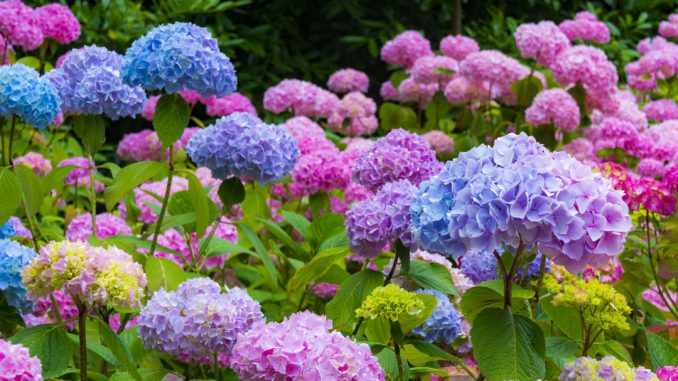
Enjoying a Canadian summer at home is especially valuable this year. The home garden is a safe and welcoming refuge, where we can consider the finer points (and some mysteries) of plants we love – in particular, those blue hydrangeas.
In a chilly spring when we yearn for floral display, pots of vividly coloured hydrangeas in corner stores and supermarkets are an easy sale. Their round heads of deeply saturated blue- and pink-hued flowers last for weeks indoors and on doorsteps, and reassure us that summer will soon arrive. Now that summer is here, what happens to those colourful hydrangeas? Not wanting to discard the plants, they’re often set out into garden beds with the expectation of more blue and pink flowers to come. That might be a gardener’s first encounter with the complexities of cold hardiness zones and the soil science that controls hydrangea coloration.
Cold hardiness for hydrangea shrubs is the first consideration. They are a large plant family with a wide spread of frost restrictions. The ‘corner store’ hydrangeas sold around spring holidays (Easter, Passover, Mother’s Day) are referred to as mop heads (Hydrangea macrophylla), and they have limited cold endurance in Canadian gardens. Mop heads bloom on old wood; that is, canes that are one year old. Their root systems and above-ground cane structure must survive the winter to put out the next season’s blooms. Canadian hardiness zone 6b is probably the coldest condition that they can tolerate (with protective bundling) and still preserve their blooming ability. In zone 6a, mop heads are root hardy, but their flower-carrying canes will die. Spring-purchased mop heads can be potted up into larger containers for summer growth, and over-wintered in a heated garage to preserve both their roots and canes.
A blue-flowering mop head cousin is the lace cap hydrangea (such as ‘Nikko Blue’), most often purchased at garden centres. Their flower heads are broadly flat, with central clusters of tight fertile buds surrounded by a flamboyant ring of sterile florets. Lace caps have softer blue to mauve colour tones and are cold hardy only to zone 6a.
Gardeners in suitably warm hardiness zones or with heated garages have cleared the first hurdle in keeping their corner store hydrangeas for another growing season. There is the story of a gardener who purchased a blue hydrangea, protected it over the winter in a garden bed, and the following summer − it bloomed pink. (If that happened to you, rest assured that you are not alone.) Mop head and lace cap hydrangeas are colour-variable and react to the chemistry of their soil. Acid soil will turn their petals blue; alkaline soil makes them pink. Soil acidity and alkalinity is measured on a scale of zero to 14, with 7 as the neutral mid-point at which acid turns to alkaline values. This is referred to as the pH of soil, the measure of acidity or alkalinity. In acid soil of 5.0 to 5.5, they will be blue; with less acidity at 6.0 to 6.5, they will be pink. Above the neutral middle point − pH7.0 − they will be creamy white. You can ask about the pH measurement of your soil at a local garden centre, or university horticulture department.
The acidity/alkalinity of soil is controlled by underlying bedrock. Granite bedrock influences toward acidity, while limestone bedrock pushes soil toward alkalinity. (Hydrangeas planted near a concrete sidewalk will also absorb alkalinity from the concrete.) The Muskoka region of Ontario and stretches of the eastern seaboard of North America (as examples, Massachusetts and New Jersey, where H. macrophylla survives the winter outdoors) have acid soil that reliably produces blue mop head hydrangeas. Southern Ontario has alkaline soil, producing pink mop head hydrangeas, and many kinds of consistently creamy white hydrangeas grow throughout all of these regions.
The deep blue and pink coloration of corner store hydrangeas is produced in the nursery by feeding plants with acid-inducing chemicals. This can be achieved in the home garden, but results are temporary and require repeat applications approximately every six weeks.
Garden centres carry soil acidifier chemicals in their fertilizer sections. (Acidifiers are also suitable for other acid-loving plants such as blueberries, holly, azaleas and rhododendrons.) Acidifier products may contain elemental sulfur and gypsum. Boxed aluminum sulfate is also sold as a soil acidifier, but its toxic properties can damage hydrangeas with repeated use. Pelleted sulfur is sold as a natural soil acidifier, and it can be dug into the soil surrounding hydrangeas. It is slowly released and may not be effective enough to produce true-blue petal coloration.
If you love blue and pink mop head hydrangeas enough to follow these guidelines, then have at it! But other beautifully coloured hydrangeas are reliably consistent in their coloration, requiring no acidity/alkalinity consideration. Fortunately, the large group of panicle hydrangeas (H. paniculata) are hardy to zone 5 and have generous flower clusters, many opening white, turning to pink and red as they age, with pink-bronze colouring into early winter. Among the pink and red varieties, look for ‘Fire and Ice’, ‘Fire Light’, ‘Vanilla Strawberry’, and ‘Pinky Winky’. Sorry, no blues; but these will certainly light up your summer garden.


